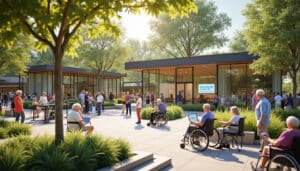The gerontechnology emerges as an innovative discipline, merging gerontology and technology with the aim of promoting the autonomy of elderly individuals. Designed to address the challenges of aging, this approach favors solutions tailored to the specific needs of vulnerable individuals. Taking into account human and societal issues, gerontechnology aims to improve daily life and prevent dependency. Thus, it positions itself as a key player in the search for a balance between well-being and health of seniors, while paving the way for significant innovations within our aging society.
Understanding gerontechnology: definition and issues
Gerontechnology is a multidisciplinary field that emerges at the intersection of gerontology and technological advancements. This term refers to the set of technologies specifically designed to meet the needs of elderly individuals, in order to promote their autonomy and quality of life. Developed in the 1990s in France, gerontechnology aims to encourage independent living while ensuring comfort and safety. Innovations in this sector seek to address the challenges related to aging, including loss of mobility, health issues, and social isolation.
The stakes of gerontechnology are numerous and “autonomy” is a central concept. By designing technological solutions, we respond not only to the needs of elderly people considered vulnerable or ill, but we also allow those in good health to continue actively participating in society. Products arising from gerontechnology may include assistance devices, tele-assistance applications, connected objects, and home automation equipment, all aimed at improving the daily lives of seniors.
One of the fundamental promises of gerontechnology is to prevent the social isolation of elderly people. Through networking, technologies enable seniors to stay connected with their surroundings, which is essential for maintaining their emotional well-being. Digital platforms and communication applications facilitate exchanges between generations, thus contributing to strengthening family and friendly ties.
Moreover, gerontechnology also symbolizes innovation in the field of care. Technological advancements enable better monitoring of the health status of elderly individuals, for example, through health sensors and telemedicine devices. These facilitate the early detection of health problems, which can lead to timely and appropriate medical interventions. By combining health services with technological tools, seniors benefit from true personalized follow-up.
Another crucial aspect to consider is the ethics associated with the use of gerontechnologies. Debates around data protection, privacy, and user consent are constantly growing. It is essential to ensure that the technologies put in place respect the dignity and rights of elderly individuals. Reflections on these ethical issues are therefore vital to guarantee a successful integration of gerontechnologies into the lives of seniors.
In conclusion, gerontechnology represents a powerful lever to improve the daily lives of elderly individuals. The solutions it offers are not limited simply to responses to the challenges posed by aging but also contribute to building an inclusive environment where seniors can age peacefully and actively. To learn more about the issues and opportunities associated with gerontechnology, you can consult articles such as the impact of technology on elder care or the challenges of the silver economy.
Frequently asked questions about gerontechnology
What are the stakes of gerontechnology? The stakes of gerontechnology include improving the autonomy of seniors, supporting caregivers, and creating innovative solutions to address the challenges of an aging population.
How does gerontechnology contribute to the autonomy of elderly individuals? Gerontechnology allows for the design of tools and devices that facilitate daily activities, thereby improving the safety and autonomy of elderly individuals living at home or in facilities.
What are the main technologies developed in the field of gerontechnology? The main technologies include home automation devices, connected objects, mobility aids, and communication tools, aiming to improve the comfort and safety of seniors.
Is gerontechnology solely intended for individuals with loss of autonomy? No, gerontechnology is also designed for healthy elderly individuals, promoting their social participation and allowing them to live under better conditions.
Are there ethical aspects related to the use of gerontechnology? Yes, it is essential to consider ethical issues, such as the protection of personal data and respect for the dignity of elderly individuals, when designing and using technologies intended for this group.
What are the benefits of gerontechnology for caregivers? Gerontechnology provides tools that facilitate the tasks of caregivers, enabling them to better manage the daily life of elderly individuals and reduce their own emotional and physical burden.










